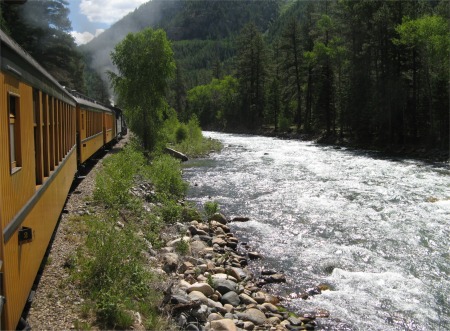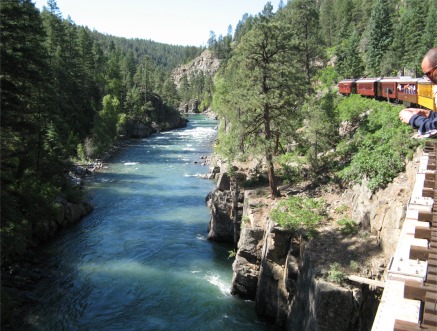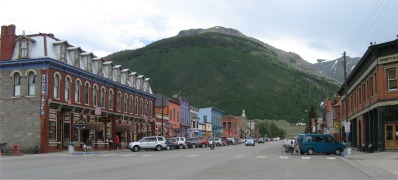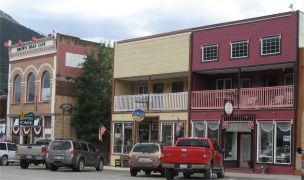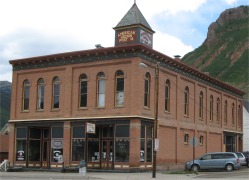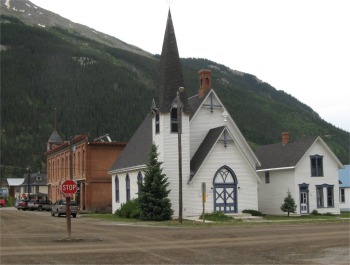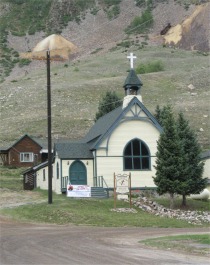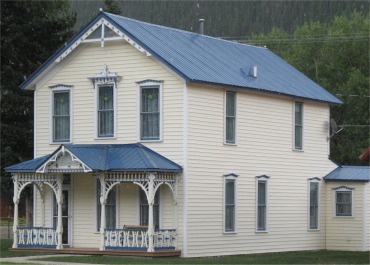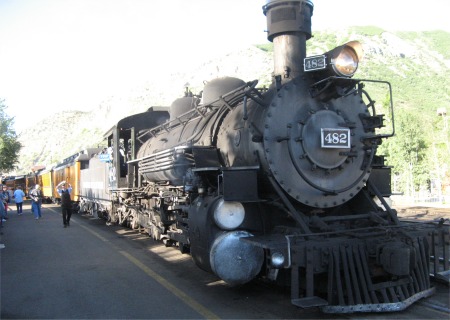 Steam Engine at Durango |
The Denver and Rio Grande Railway arrived in Durango on August 5th 1881 and construction on the line began in the fall of that same year. By July of 1882 (just nine months after construction began) the tracks to Silverton were completed. The line was constructed to haul silver and gold ore from the mountains, but passengers soon realised it was the view that was truly precious. This scenic line had been in operation ever since.
I was parked up near the station well before 7am, and had a chance to enjoy a coffee in the morning sun before the crowds arrived. With a fanfare of tooting, the engine pulled into the station to couple up with the train, puffing a rich cloud of smoke out of its stack, and steam hissing out from deep within the bowels of the Iron Horse. The combined smell of the sulphurous smoke and steam had a wonderful aroma that reminded me of my childhood.
The train itself comprised a string of yellow open gondolas and carriages, and appended on the rear was another string of rusty red enclosed carriages; the whole representing a step back in time of almost 130 years.
Nostalgic seniors, anorak adults and kids buzzed around snapping pictures, and there was an air of excitement around the station. Soon we were all seated and underway. The train slowly ambled through Durango, the tracks running through the town at street level with no barriers to protect them. Rail workers with flags served as automatic barriers to halt the traffic, though the amount of tooting going on should have warned all vehicles within 200m that a train was on the move.
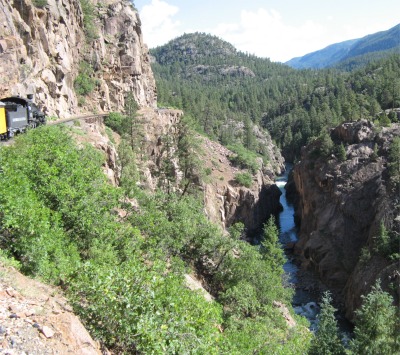 Narrow Ledge above the Animas River |
Shortly we were passing through narrow ravines alongside the river that was rushing and gushing onto its final resting place in the ocean.
I had two sets of neighbours in the open gondola that I was traveling in. One set comprised a chap from Phoenix and a woman from New Mexico. They had left Wisconsin and Michigan respectively to seek the warmer climates in the south west. The woman had studied at the Slade in London at one time, so we had a chat on art.
The other set were a young couple with a small girl and an 8 month old son. They were from Louisiana, and I was pleased that at last I had been able to place an American accent, albeit from the deep south. The chap and I were soon chatting about the deep south. He and his family were enjoying a one week vacation. Being self employed he could take two weeks per year, but his wife, a nurse, was restricted to one.
 Black Bear Cub by the Train |
|
|
 Cowboy and his Horses |
Occasionaly we would see fishermen, rafters and canoeists on or by the river. We stopped at one point where hikers alighted from the train, and other folk climbed down to join a cowboy and his horses for a horse ride to God knows where.
I had a cuddle of baby William, a gorgeous wee fellow, and later I watched him being bottle fed. It was then that I noticed something odd about the bottle; it had no bottom. The milk was contained in a transparent plastic bag that fitted inside the hollow bottle, and was attached to the screw neck. There were two advantages to this form of bottle feeding. Firstly, the plastic bag just kept collapsing as the milk was drunk, so there was no chance of the baby taking in air. Secondly, only the teat and screw top ever need steralising. This, to me, was a brilliant idea, and I couldn't remember having seen such bottles in the UK, though perhaps they do exist.
 Notorious Silverton Blair Street Rail Terminus |
We rolled into Silverton just as a shower hit the station. The family was going to take the bus back to Durango; a shorter journey time by two hours which would have been better for their children. They were a happy, loving family, devoted to their kids. I wished them well for their future prosperity and their children's future. I alighted from the train onto one of Silverton's dirt roads.
It was 1860 when Charles Baker and several prospectors entered the San Juan Mountains in search of wealth. They soon found deposits of gold and silver along the Animas River, in an area that was later called "Baker's Park". The prospectors stayed through the summer but returned to what is now New Mexico for the winter. News spread of the discovery; however, with the Civil War looming and the discovery being located on Ute Indian land, the miners did not return to the San Juan Mountains until early 1870s.
At that time nearly 1,000 prospectors once again ventured into the high country. The Utes protested, yet they could not stop the inexorable wave of miners and settlers that arrived over Stony Pass.
In 1874 Silverton's town site was laid out and it soon became the centre of numerous mining camps. By 1883, Silverton boasted of having a population of 2,000 people with 400 buildings - 2 banks, 5 laundries, 29 saloons, several hotels and a bawdy red light district - Notorious Blair Street.
As early as 1874, men were bringing their wives and families to live in Silverton. The influx of families provided an incentive for citizens to keep at least part of Silverton respectable. From the very beginning an imaginary line ran down Greene Street dividing the town between the law-abiding, church-going residents and the gamblers, prostitutes, variety theatres, dance halls and saloons.
|
|
|
The train, of course, had pulled up in the middle of Blair Street, once hub of the red light district. After a quick wash to remove the layer of soot on me, and a quick breakfast of chili with extra jalapenos, I walked the few yards up to Greene Street. This street was the only paved street in Silverton, the rest were all compressed gravel roads.
|
|
|
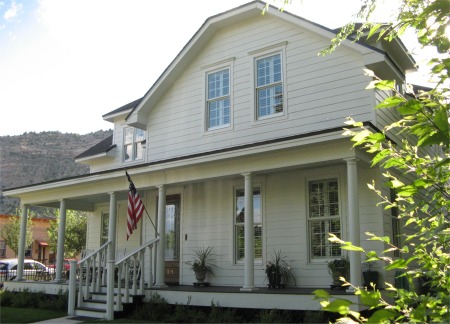 Elegant Durango House |
On my arrival back at Durango, I had a look around the train museum, strolled around the posh old mansions on 3rd Street (it had often been said billionaires were now squeezing out Durango's millionaires), grabbed a quick meal, had a walk along the river, before visiting The Henry Slater Theatre.
I turned up at the theatre only minutes before the evening performance, to see a melodrama by George Cohan, "The Tavern", that would be followed by some Vaudeville. The play was hilarious, and what also amazed me was how the whole set up was run. During the day the performers were on the streets drumming up customers for the performances, as well as rehearsing. During the interval, they also came around the tables taking orders and serving drinks.
At the end of the brilliant performance, there was ten minutes to kill before the Vaudeville started. The compere/stand-up comedian/pianist needed a member of the audience to assist him, and guess who he picked on. I seem to fall for this every time. The routine was he would come out with a load quick one-liners, and I had had to respond by shouting "Hey, that's great" or "Hey, that's bad". Of course his lightening speed of delivery soon had me tied up in knots and I was responding to "My friend got married today" with "Hey, that's bad", and I was making a complete mess of it, which was the intention. The audience loved it. The follow up Vaudeville was a hoot. It was a perfect way to conclude my stay in Durango.

